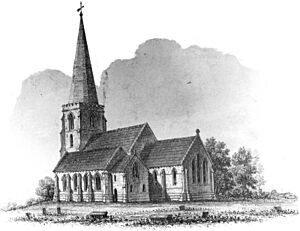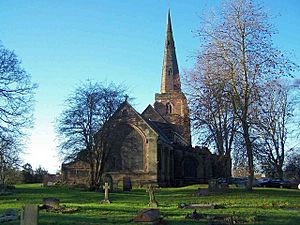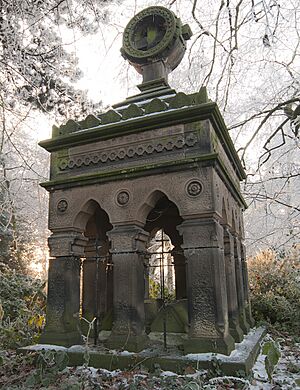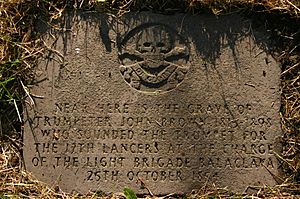St Michael on Greenhill, Lichfield facts for kids
Quick facts for kids St Michael on Greenhill, Lichfield |
|
|---|---|
 |
|
| 52°41′00″N 1°49′06″W / 52.683283°N 1.818300°W | |
| Location | Lichfield, Staffordshire |
| Country | England |
| Denomination | Anglican |
| Architecture | |
| Functional status | Active |
| Heritage designation | Grade II* |
| Architect(s) | Thomas Johnson |
| Style | Early English, Gothic |
| Completed | 1843 |
| Administration | |
| Parish | Lichfield |
| Diocese | Lichfield |
| Province | Canterbury |
St Michael on Greenhill is a church located in Lichfield, Staffordshire, England. It sits on a high piece of land called Greenhill, on the east side of the city.
People have worshipped on this spot since at least the year 1190. The church building you see today was mostly rebuilt between 1842 and 1843. The churchyard around it is very old and large, covering about 9 acres (36,000 square meters). It is one of the biggest churchyards in England.
The church is a special building because it is "Grade II* listed." This means it is an important historic building that needs to be protected. Some of the old monuments in the churchyard are also listed as Grade II.
Contents
A Look Back in Time
An Ancient Burial Place
The church stands on a sandstone ridge, about 104 meters (341 feet) above sea level. From here, you can look down over the city of Lichfield. This high spot has been important for a very long time.
The first mention of St Michael's Church at Greenhill was in 1190. However, the area itself has a much older story. Scientists have found ancient flint tools from the Mesolithic period (Middle Stone Age) in the churchyard. These tools suggest that people might have lived or worked here thousands of years ago. It could even be one of the very first settlements in Lichfield.
Before the church was built, this site was a very important burial ground. It is one of only five ancient burial grounds known in England. Some old stories say that Saint Augustine himself made the ground holy. It's also believed that this ancient holy site in Mercia (an old kingdom) helped convince Saint Chad to come to Lichfield. This made Lichfield a very important religious center.
We can see how old this site is by finding "crouched burials." These are a type of burial where the body is placed in a curled-up position. This was more common before the Normans came to England in 1066.
The churchyard is very large, originally about 7 acres (28,000 square meters) and later growing to 9 acres. Some people think it was a burial place for early Christians or even a large burial ground for a whole tribe. However, its size might simply be because it was the main graveyard for Lichfield and the nearby areas for many centuries.
The Medieval Church
The first church on this site was recorded in 1190. It might have been a small chapel for the cemetery. The oldest parts of the church that are still standing today are some stone walls in the chancel (the area around the altar) from the 13th century. The church's official record book, called the church register, dates back to 1574.
The tall west tower was built in the 1400s using local red sandstone. It has a style called Perpendicular Gothic and a spire that goes inwards at the top. In 1594, a strong wind blew down the spire. By 1601, money was spent to rebuild the tower and add a weathercock (a metal rooster that shows wind direction) on top.
For a long time, from the 1500s to the 1800s, the churchyard at St Michael's was used to graze sheep and cattle belonging to the local people. This practice stopped in the 19th century, allowing the churchyard to become a more natural area.
The Church Building Today
Much of the old medieval church was changed during a big "restoration" project in 1842-43. This work was designed by a local architect named Thomas Johnson.
During this time, the roof of the nave (the main part of the church where people sit) was replaced. The side aisles and the clerestory (the upper part of the nave with windows) were repaired. New windows were added to the north aisle, and the north porch was rebuilt. The south aisle was also changed, with new supports called buttresses and a new south door.
An old mausoleum (a building for burials) and a vestry room (where clergy prepare) were replaced. A new clergy vestry was built above a stokehole (for heating), with doors leading to the chancel and south aisle. An organ loft (where the organ is placed) was built above the vestry. A clock was put on the tower in 1814.
More work was done in 1845 and 1846 by architect Sydney Smirke. The east window was changed to have three lights, and all the side windows became single lancets (tall, narrow windows). The clerestory was removed. In the late 1870s, a stone pulpit (where sermons are given) was put in, and new seating was added in the mid-1880s.
Even more changes happened in 1890–91, designed by John Oldrid Scott. The chancel was restored and updated. The tower was repaired, and a blocked-up window inside was opened again. In 1906, the spire was repaired after a storm, and a new weather vane was put up. A new vestry was added in 1923.
Interesting Features Inside and Out
- In the middle of the church's main area (the nave) is a special stone slab on the floor. It remembers Samuel Johnson's father Michael (who died in 1731), his mother Sarah (who died in 1759), and his brother Nathaniel (who died in 1737). All of them were buried in this church. This stone was placed there in 1884 to mark 100 years since Samuel Johnson passed away. The words on the stone were written by Johnson himself for an earlier stone.
- Above the arch leading to the chancel, you can see the royal coat of arms of Queen Anne (who ruled from 1702–14). After the monarchy was restored in England, churches had to show these symbols to prove their loyalty to the King or Queen.
- The font, which is used for baptisms, dates from 1669. It has eight sides and is decorated with designs like the fleur-de-lis (a lily symbol) and Tudor roses.
- In a special area in the north wall of the chancel, under a pointed arch, is the tomb of William de Walton. He was the first person recorded to give money to St Michael's, back in 1344.
- Also in the chancel is a stone figure of a man in everyday clothes. People believe he was a lawyer from the 1300s.
- In 1552, the church had three bells. In 1722 or 1723, a set of six bells was made by Abraham Rudhall of Gloucester. Two of these bells were remade in 1919.
- In the churchyard, you can find the grave of Trumpeter John Brown. He was a trumpeter for the 17th Lancers and sounded the trumpet during the famous Charge of the Light Brigade battle.
- There is also a gravestone for John Neve, William Wightman, and James Jackson in the churchyard. These men were found guilty of forgery and were executed in 1810. The gravestone only shows their initials and the date June 1, 1810. It was recently restored after being found fallen over and covered in moss.
- The mausoleum of James Thomas Law (1790–1876) is at the northern edge of the churchyard. He was an important church official in Lichfield. He built it for his wife, who died in 1864. It looks like an old medieval tomb with a canopy. It used to have a clock with two faces that lit up at night. This clock helped travelers on their way to the railway station know the time. The clock is now gone, and the mausoleum is covered in plants. It is also a Grade II Listed Building.
- There are two other Grade II listed monuments and one listed headstone (for Mary Gregory, who died in 1687) in the churchyard.
- A special wall memorial, put up by the Commonwealth War Graves Commission, remembers 35 soldiers from World War I and World War II who are buried in the churchyard.
St Michael's Today
St Michael's is still a busy church for the local community. The old church areas of St Mary's and St Michael's have joined together. St Michael's is now the main church, and St Mary's is used for some services. Along with St John's at Wall, they form a group of churches called the United Benefice.
Regular church services are held on Sundays, Tuesdays, and Wednesdays. Weddings, baptisms (christenings), and funerals also take place here. There is also a Sunday school for children.
The churchyard is now looked after as a place for wildlife.
The rectory (the house where the church's rector lives) was built in the 1970s on St Michael's Road. It replaced an older house from 1858. This new house is still the home for the rector of the combined churches.
Images for kids
See also
- Grade II* listed buildings in Lichfield (district)
- Listed buildings in Lichfield






